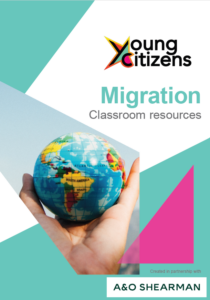Overview
To help you engage your students in the topic of migration Young Citizens have developed a flexible teaching resource for delivery during curricular or extra-curricular sessions.
This resource:

- explores the various reasons that lead people to migrate
- unpacks the differences between refugees, asylum seekers and other migrants
- examines key pieces of legislation to see what rights migrants have in national and international law
- analyses a number of real life case studies
Acknowledgements:
This classroom resource was developed in partnership with international law firm A&O Shearman, who provide legal services to global businesses and industry. Their support enabled this specialist resource to be distributed to schools for free.
Suggested Next Steps:
- See other free teaching resources that we offer.
- Look into our subscription based programmes.
- Learn more about why citizenship education is important.
More Lessons resources
How Does the Budget Impact Me and Others?
The resource consists of two activities. The first is a notation task based on the information provided about the...
An Introduction to Human Rights
In this lesson students will explore our rights and responsibilities and how they are protected in law. They are...
Citizenship and the Wider World
During this lesson pupils consider what it means to be a global citizen and what rights and responsibilities come with this. They consider a range of global issues; analysing…
More Community resources
COP: Climate Action
In November 2021, COP26 took place in Glasgow. It was the most pivotal climate summit of all time. This resources will explore what COP is and what COP26 aimed to…
How to share learning with your peers
Originally designed to be a companion pack for the Democracy Ambassadors programme, this handy toolkit will support students who...
What is a Charity?
Pupils learn about the reasons why charities are created. They will be introduced to the main features of a charity and have the opportunity to research the work of a…
More Diversity and Inclusion resources
Martin Luther King: Sacrificing All for the Dream
This lesson looks at discrimination against African Americans in the United States during the 1950s and 1960s, the Civil Rights Movement and how Martin Luther King achieved change through peaceful…
Family Law – Cohabitation and Marriage (SmartLaw Subscription)
During the course of the lesson students will learn the difference between marriage and cohabitation and consider what legal rights come with both. Students will explore the changing attitudes in…
I Am Unique
This lesson focuses on celebrating diversity and respecting differences. During the lesson pupils will gain an understanding of what it means to be unique through participating in a range of…
More Politics and Democracy resources
Democracy (Part 2): Local and Central Government
This lesson forms the second part of a three-part unit on democracy. Pupils learn about the function of central and local government and the difference between MPs and councillors. Pupils explore…
The Economy Quiz
In this short, 15 minute activity students use all they have learnt from earlier lessons to complete a quiz...
Voting and the General Election
This resource pack is the second of a four-part set which has been designed to introduce students to the...
More Understanding Rules & The Law resources
Discrimination
In this lesson pupils will develop their understanding of the term ‘discrimination’. Pupils will consider what makes them unique and learn which characteristics are protected under the Equality Act. Pupils…
Law in Wales
Did you know that the age of criminal responsibility in Wales is ten? In Scotland it is 12. In...
What is the Law?
Watch a read-aloud version of the book ‘What is the Law?’, in which a hedgehog called Snippet finds out about the law. The book has been separated into four chapters…
More KS3 (ages 11-14) resources
Who’s to Blame? (SmartLaw Subscription)
This activity is based on the case of R v. Dudley and Stephens (1884) – two sailors accused of murdering cabin boy Richard Parker, after being cast adrift on the…
Crime and its Impact (SmartLaw Subscription)
Students explore the impact of crime on those surrounding the victim and the perpetrator and consider the financial, physical and emotional ripples that crime can have on a community. Please…
You Decide! (KS3)
This resource will allow students to critically consider what reasons and ways the government can take to support different...
More KS4 (ages 14-16) resources
Who’s to Blame? (SmartLaw Subscription)
This activity is based on the case of R v. Dudley and Stephens (1884) – two sailors accused of...
Housing Law (SmartLaw Subscription)
In this lesson students explore a range of different housing situations someone can find themselves in. They examine some of the common legal issues concerning housing including common landlord and…
Climate Action: Circular Economies
During this lesson students explore how the economy can be used to support climate action and create a more...
